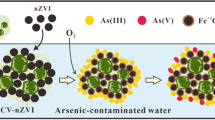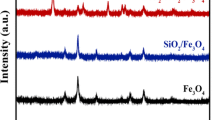Abstract
Increasing applications of metal oxide nanoparticles and their release in the natural environment is a serious concern due to their toxic nature. Therefore, it is essential to have eco-friendly solutions for the remediation of toxic metal oxides in an aqueous environment. In the present study, eco-friendly Iron Oxide Nanoparticles (IONPs) are synthesized using solvothermal technique and successfully characterized using scanning and transmission electron microscopy (SEM and TEM respectively) and powder X-Ray diffraction (PXRD). These IONPs were further utilized for the remediation of toxic metal oxide nanoparticle, i.e., CeO2. Sorption experiments were also performed in complex aqueous solutions and real water samples to check its applicability in the natural environment. Reusability study was performed to show cost-effectiveness. Results show that these 200 nm-sized spherical IONPs, as revealed by SEM and TEM analysis, were magnetite (Fe3O4) and contained short-range crystallinity as confirmed from XRD spectra. Sorption experiments show that the composite follows the pseudo-second-order kinetic model. Further R2>0.99 for Langmuir sorption isotherm suggests chemisorption as probable removal mechanism with monolayer sorption of CeO2 NPs on IONP. More than 80% recovery of adsorbed CeO2 NPs through ultrasonication and magnetic separation of reaction precipitate confirms reusability of IONPs. Obtained removal % of CeO2 in various synthetic and real water samples was>90% signifying that IONPs are candidate adsorbent for the removal and recovery of toxic metal oxide nanoparticles from contaminated environmental water samples.

Similar content being viewed by others
References
Ali A, Zafar H, Zia M, Ul Haq I, Phull A R, Ali J S, Hussain A (2016). Synthesis, characterization, applications, and challenges of iron oxide nanoparticles. Nanotechnology, Science and Applications, 9: 49–67
Chang M R, Lee D J, Lai J Y (2007). Nanoparticles in wastewater from a science-based industrial park: Coagulation using polyaluminum chloride. Journal of Environmental Management, 85(4): 1009–1014
Chen Y, Bylaska E J, Weare J H (2017). Weakly bound water structure, bond valence saturation and water dynamics at the goethite (100) surface/aqueous interface: ab initio dynamical simulations. Geochemical Transactions, 18(1): 3
Chien S H, Clayton W R, Mcclellan G H (1980). Kinetics of dissolution of phosphate rocks in soils. Soil Science Society of America Journal, 44(2): 260–264
Darbha G K, Fischer C, Luetzenkirchen J, Schäfer T (2012). Site-specific retention of colloids at rough rock surfaces. Environmental Science & Technology, 46(17): 9378–9387
Darbha G K, Schäfer T, Heberling F, Lüttge A, Fischer C (2010). Retention of latex colloids on calcite as a function of surface roughness and topography. Langmuir, 26(7): 4743–4752
Darbha G K, Singh A K, Rai U S, Yu E, Yu H, Chandra Ray P (2008). Selective detection of mercury (II) ion using nonlinear optical properties of gold nanoparticles. Journal of the American Chemical Society, 130(25): 8038–8043
Deng Y, Qi D, Deng C, Zhang X, Zhao D (2008). Superparamagnetic high-magnetization microspheres with an Fe3O4@SiO2 core and perpendicularly aligned mesoporous SiO2 shell for removal of microcystins. Journal of the American Chemical Society, 130(1): 28–29
Dvořák F, Szabová L, Johánek V, Farnesi Camellone M, Stetsovych V, Vorokhta M, Tovt A, Skála T, Matolínová I, Tateyama Y, Mysliveček J, Fabris S, Matolín V (2018). Bulk hydroxylation and effective water splitting by highly reduced cerium oxide: The role of O vacancy coordination. ACS Catalysis, 8(5): 4354–4363
Gan G, Liu J, Zhu Z, Yang Z, Zhang C, Hou X (2017). A novel magnetic nanoscaled Fe3O4/CeO2 composite prepared by oxidation-precipitation process and its application for degradation of orange G in aqueous solution as Fenton-like heterogeneous catalyst. Chemosphere, 168: 254–263
Ganesh R, Smeraldi J, Hosseini T, Khatib L, Olson B H, Rosso D (2010). Evaluation of nanocopper removal and toxicity in municipal wastewaters. Environmental Science & Technology, 44(20): 7808–7813
Gunawan C, Lord M S, Lovell E, Wong R J, Jung M S, Oscar D, Mann R, Amal R (2019). Oxygen-vacancy engineering of cerium-oxide nanoparticles for antioxidant activity. Acs Omega, 4(5): 9473–9479
He Q G, Liu J, Liang J, Liu X P, Ding Z Y, Tuo D, Li W (2018). Sodium acetate orientated hollow/mesoporous magnetite nanoparticles: Facile synthesis, characterization and formation mechanism. Applied Sciences-Basel, 8(2): 10.3390/app8020292
Ho Y S, Mckay G (1999). Pseudo-second order model for sorption processes. Process Biochemistry, 34(5): 451–465
Hua M, Zhang S, Pan B, Zhang W, Lv L, Zhang Q (2012). Heavy metal removal from water/wastewater by nanosized metal oxides: A review. Journal of Hazardous Materials, 211–212: 317–331
Juganson K, Ivask A, Blinova I, Mortimer M, Kahru A (2015). NanoE-Tox: New and in-depth database concerning ecotoxicity of nanomaterials. Beilstein Journal of Nanotechnology, 6: 1788–1804
Kaegi R (2009). Nanoparticles in drinking water. EAWAG News, 66
Khandelwal N, Singh N, Tiwari E, Darbha G K (2019). Novel synthesis of a clay supported amorphous aluminum nanocomposite and its application in removal of hexavalent chromium from aqueous solutions. RSC Advances, 9(20): 11160–11169
Kumari M, Singh S P, Chinde S, Rahman M F, Mahboob M, Grover P (2014). Toxicity study of cerium oxide nanoparticles in human neuroblastoma cells. International Journal of Toxicology, 33(2): 86–97
Langmuir I (1918). The adsorption of gases on plane surfaces of glass, mica and platinum. Journal of the American Chemical Society, 40(9): 1361–1403
Largitte L, Pasquier R (2016). A review of the kinetics adsorption models and their application to the adsorption of lead by an activated carbon. Chemical Engineering Research & Design, 109: 495–504
Lin W, Huang Y W, Zhou X D, Ma Y (2006). Toxicity of cerium oxide nanoparticles in human lung cancer cells. International Journal of Toxicology, 25(6): 451–457
Lin Y T, Sung M, Sanders P F, Marinucci A, Huang C P (2007). Separation of nano-sized colloidal particles using cross-flow electrofiltration. Separation and Purification Technology, 58(1): 138–147
Liu J F, Sun J, Jiang G B (2010). Use of cloud point extraction for removal of nanosized copper oxide from wastewater. Chinese Science Bulletin, 55(4–5): 346–349
Masserini M (2013). Nanoparticles for brain drug delivery. ISRN Biochemistry, 2013: 238428–238428
Morales M I, Rico C M, Hernandez-Viezcas J A, Nunez J E, Barrios A C, Tafoya A, Flores-Marges J P, Peralta-Videa J R, Gardea-Torresdey J L (2013). Toxicity assessment of cerium oxide nanoparticles in cilantro (Coriandrum sativum L.) plants grown in organic soil. Journal of Agricultural and Food Chemistry, 61(26): 6224–6230
Omar S (2019). Doped ceria for solid oxide fuel cells. Intech Open, Chapter 4:43–59
Pang L, Liu J F (2013). Use of Fe3O4@nSiO2@mSiO2 magnetic mesoporous microspheres for fast determination of the sorption coefficients of polycyclic aromatic hydrocarbons to bovine serum albumin in aqueous phase. Acta Chimica Sinica, 71(3): 339–342
Pujar M S, Hunagund S M, Desai V R, Patil S, Sidarai A H (2018). One-step synthesis and characterizations of cerium oxide nanoparticles in an ambient temperature via Co-precipitation method. AIP Conference Proceedings, 1942(1): 050026
Ranjit K, Ahmed A (2013). Nanoparticle: An overview of preparation, characterization, and application. Journal of Applied Pharmaceutical Science, 1(6): 228–234
Sen Gupta S, Bhattacharyya K G (2011). Kinetics of adsorption of metal ions on inorganic materials: A review. Advances in Colloid and Interface Science, 162(1–2): 39–58
Smith E J, Davison W, Hamilton-Taylor J (2002). Methods for preparing synthetic freshwaters. Water Research, 36(5): 1286–1296
Springer F, Laborie S, Guigui C (2013). Removal of SiO2 nanoparticles from industry wastewaters and subsurface waters by ultrafiltration: Investigation of process efficiency, deposit properties and fouling mechanism. Separation and Purification Technology, 108: 6–14
Srinivas A, Rao P J, Selvam G, Murthy P B, Reddy P N (2011). Acute inhalation toxicity of cerium oxide nanoparticles in rats. Toxicology Letters, 205(2): 105–115
Srivastava S K, Tyagi R, Pant N (1989). Adsorption of heavy-metal ions on carbonaceous material developed from the waste slurry generated in local fertilizer plants. Water Research, 23(9): 1161–1165
Stachowicz M, Hiemstra T, van Riemsdijk W H (2007). Arsenic-bicarbonate interaction on goethite particles. Environmental Science & Technology, 41(16): 5620–5625
Suzuki T, Kosacki I, Anderson H U (2002). Defect and mixed conductivity in nanocrystalline doped cerium oxide. Journal of the American Ceramic Society, 85(6): 1492–1498
Teng W Y, Jeng S C, Kuo C W, Lin Y R, Liao C C, Chin W K (2008). Nanoparticles-doped guest-host liquid crystal displays. Optics Letters, 33(15): 1663–1665
Trovarelli A (1996). Catalytic properties of ceria and CeO2-containing materials. Catalysis Reviews, 38(4): 439–520
Wiechers J W, Musee N (2010). Engineered inorganic nanoparticles and cosmetics: facts, issues, knowledge gaps and challenges. Journal of Biomedical Nanotechnology, 6(5): 408–431
Xu H, Sun Y, Li J, Li F, Guan X (2016). Aging of zerovalent iron in synthetic groundwater: X-ray photoelectron spectroscopy depth profiling characterization and depassivation with uniform magnetic field. Environmental Science & Technology, 50(15): 8214–8222
Yang S, Zeng T, Li Y, Liu J, Chen Q, Zhou J, Ye Y, Tang B (2015). Preparation of graphene oxide decorated Fe3O4@SiO2 nanocomposites with superior adsorption capacity and SERS detection for organic dyes. Journal of Nanomaterials, 2015: 8
Zachara J M, Girvin D C, Schmidt R L, Resch C T (1987). Chromate adsorption on amorphous iron oxyhydroxide in the presence of major groundwater ions. Environmental Science & Technology, 21(6): 589–594
Zamiri R, Abbastabar Ahangar H, Kaushal A, Zakaria A, Zamiri G, Tobaldi D, Ferreira J M F (2015). Dielectrical properties of CeO2 nanoparticles at different temperatures. Plos One, 10(4): e0122989
Zargoosh K, Abedini H, Abdolmaleki A, Molavian M R (2013). Effective removal of heavy metal ions from industrial wastes using thiosalicylhydrazide-modified magnetic nanoparticles. Industrial & Engineering Chemistry Research, 52(42): 14944–14954
Zhou X X, Li Y J, Liu J F (2017). Highly efficient removal of silver-containing nanoparticles in waters by aged iron oxide magnetic particles. ACS Sustainable Chemistry & Engineering, 5(6): 5468–5476
Acknowledgements
We recognize financial support from the SERB-Ramanujan Fellowship grant (SB/S2/RJN-006/2016) and SERB-ECR project grant (ECR/2017/000707) from Department of Science and Technology (DST), India. We are also thankful to the Indian Institute of Science Education and Research Kolkata’s central instrumentation facility for TEM, FESEM, and PXRD analysis.
Author information
Authors and Affiliations
Corresponding author
Additional information
Highlights
• Eco-friendly IONPs were synthesized through solvothermal method.
• IONPs show very high removal efficiency for CeO2 NPs i.e. 688 mg/g.
• Removal was >90% in all synthetic and real water samples.
• >80% recovery of CeO2 NPs through sonication confirms reusability of IONPs.
Rights and permissions
About this article
Cite this article
Gupta, K., Khandelwal, N. & Darbha, G.K. Removal and recovery of toxic nanosized Cerium Oxide using eco-friendly Iron Oxide Nanoparticles. Front. Environ. Sci. Eng. 14, 15 (2020). https://doi.org/10.1007/s11783-019-1194-4
Received:
Revised:
Accepted:
Published:
DOI: https://doi.org/10.1007/s11783-019-1194-4




